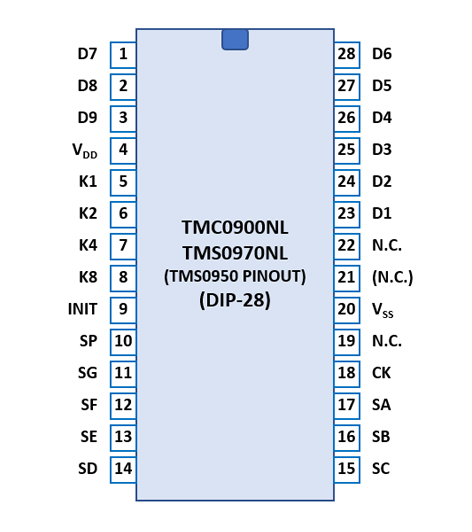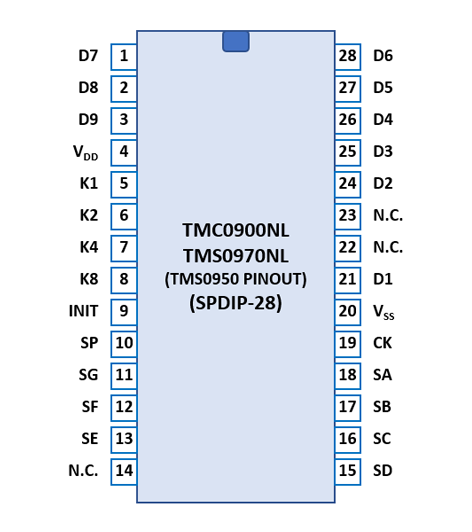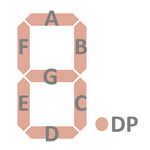
DATAMATH CALCULATOR MUSEUM
 |
DATAMATH CALCULATOR MUSEUM |
When Texas Instruments introduced in 1975 with the TMS0950 its first "real" single-chip calculator based on the TMS1000 design, they needed to reduced the number of digit outputs from 11 to 9 to maintain the use of a small 28-pin package. Not a big deal for basic calculators but still a limitation of the true capabilities of its underlying TMS1000 architecture. The next iteration of TI's single-chip calculator designs with integrated segment and digit drivers eliminated some of the external components used with the TMS0950, freeing up a total of three pins and the TMS0970 consequently features 11 digit outputs. As of today we know with the TMS0973 located in a Bearcat BC-210 Radio Scanner only one product using the full feature set of chip, most of its applications are either replacements of former TMS0950 designs or use LED displays with a maximum of 9 digits. In typical calculator applications of the TMS0970 as pin-compatible and cost-optimized upgrade of the TMS0950, it is effectively dropping 4 resistors and 1 capacitor from the printed circuit board (PCB) and shrinking its silicon area by almost 30%.
Based on the Digit Processor architecture of the TMS1000 Microcomputer and featuring a large program memory with 1,024 Bytes ROM (Read-Only Memory) capacity and a flexible RAM (Random-Access Memory) with 256 Bits organized in 4 files of 16 Digits, each plus integrated segment and digit drivers for an 8-digit LED display and everything powered by a small 9V alkaline battery, the TMS0970 found its way into many products. Most successful was certainly the Little Professor introduced in 1976 but Texas Instruments sold a basic design (TMS0972, four-banger with 4-key memory) to third party manufactures, too and it proofed to be very successful with OEMs in Hong Kong around 1977 and 1978 with what we call here in the Datamath Calculator Museum "Far East Generic Design I, Design II, and Design III".
With millions and millions of the TMS1000 Microcomputer deployed in hundreds of customer designs by 1977 and the TMS0970 basically a very cost-effective way to implement electronic consumer products, Texas Instruments started marketing the design as TMC0900 (C as in Customer) and the chip found its way into various electronic games and toys.
With calculator prices dropping in 1977 significantly below the $10 mark, Texas Instruments introduced in 1977 both a cost-optimized version of the TMS0970/TMC0900 in a 28-pin Shrink Plastic Dual In-line Package and a design variation replacing a conventional [ON-OFF] switch with a simple push-button [ON] key as TMC1990.
QUICK-LINK to Calculator Circuits with LED Direct-Drive.
| Type | Calculators | Digits |
| TMS0972 | TI-1200, TI-1250 | 8 or sign + 7 |
| TMS0973 | Bearcat 210 | 10 |
| TMS0974/ZA0355 | TI-1270, Western Auto Citation | 8 or sign + 7 |
| TMS0975/ZA0356 | Little Professor (1976) | 9 |
| TMC0904 | Milton Bradley COMP IV | 0 + 10 LEDs |
| TMC0905 | Parker Brothers Code Name:Sector | 6 + 4 LEDs |
| TMC0907/ZA0379 | WIZ-A-TRON (1977), MATH MAGIC | 9 |
| Description | Comments | |
| Architecture | Single-chip Calculator | Basic, Educational, Toys |
| Category | Digit Processor | 4-bit Digits |
| Related |
TMS1000 Portfolio TMS0950 |
Original design |
| ROM Size | 8,192 Bits | 1024 Words * 8 Bits |
| RAM Size | 256 Bits | 64 Digits |
| Outputs | 11 Digits, 8 Segments (Native Pinout) 9 Digits, 8 Segments (TMS0950 Pinout) |
Internal Digit and Segment Drivers |
| Inputs | 4 Keyboard 1 Oscillator Mode 1 Reset |
Segments to Keyboard Scan-Matrix |
The Datamath Calculator Museum DCM-50A (Platform) supports the TMS0970/TMC0900 Product Family with the TMS0900 Adapter plugged into the right-most TMS1000 Textool Test Socket set to DCM-50A (TMS0900) mode. Both Characterization of TMS0970/TMC0900 Calculator Circuits and Reverse-engineering of TMS0970/TMC0900 Calculator Circuits is supported by the DCM-50A (TMS0900).
| Item | Min | Typ | Max | Unit | Comments |
| VSS | 0 | V | |||
| VDD | -9.0 | V | |||
| CK | 200 | 250 | 300 | kHz | Internal oscillator |
The TMS0970A and TMC0900A were manufactured in a 8.0 um metal gate PMOS process (metal width = 0.30 mil / 8.0 um, metal spacing = 0.30 mil / 8.0 um, diffusion width = 0.25 mil / 6.0 um, diffusion spacing = 0.30 mil / 8.0 um).
The die sizes of the TMS0970A and TMC0900A are approximately 190 mils * 160 mils / 4.8 mm * 4.0 mm.
The TMS0970AS and TMC0900AS were manufactured in a 6.0 um metal gate PMOS process (metal width = 0.25 mil / 6.0 um, metal spacing = 0.25 mil / 6.0 um, diffusion width = 0.20 mil / 5.0 um, diffusion spacing = 0.20 mil / 5.0 um).
The die sizes of the TMS0970AS and TMC0900AS are approximately 170 mils * 145 mils / 4.3 mm * 3.6 mm.
The TMS0970A(S) and TMC0900A(S) are using either a 0.6” wide 28-pin DIP (Plastic Dual In-line Package with a 0.1” / 2.54 mm lead pitch)
or a 0.4” wide 28-pin SPDIP (Shrink Plastic Dual In-line Package with a 0.07” / 1.778 mm lead pitch).
Please notice the different pinouts of the two packages.
DIP-28 (NATIVE PINOUT)
| Pin | IO | Function | Pin | IO | Function |
| 1 | O | R7 Output | 28 | O | R6 Output |
| 2 | O | R8 Output | 27 | O | R5 Output |
| 3 | O | R9 Output | 26 | O | R4 Output |
| 4 | V | Negative Voltage VDD | 25 | O | R3 Output |
| 5 | I | K1 Input | 24 | O | R2 Output |
| 6 | O | R10 Output | 23 | Not connected | |
| 7 | I | K2 Input | 22 | O | R1 Output |
| 8 | I | K4 Input | 21 | O | R0 Output |
| 9 | I | K8 Input | 20 | V | Common Voltage |
| 10 | I | INIT (Reset) | 19 | I | Clock mode |
| 11 | O | O7 Output | 18 | O | O0 Output |
| 12 | O | O6 Output | 17 | O | O1 Output |
| 13 | O | O5 Output | 16 | O | O2 Output |
| 14 | O | O4 Output | 15 | O | O3 Output |
 DIP-28
(TMS0950 PINOUT)
DIP-28
(TMS0950 PINOUT)| Pin | IO | Function | Pin | IO | Function |
| 1 | O | Digit driver 7 | 28 | O | Digit driver 6 |
| 2 | O | Digit driver 8 (sign/MSD) | 27 | O | Digit driver 5 |
| 3 | O | Digit driver 9 (n.c.) | 26 | O | Digit driver 4 |
| 4 | V | Negative Voltage VDD | 25 | O | Digit driver 3 |
| 5 | I | Keymatrix input 1 | 24 | O | Digit driver 2 |
| 6 | I | Keymatrix input 2 | 23 | O | Digit driver 1 (LSD) |
| 7 | I | Keymatrix input 4 | 22 | Not connected | |
| 8 | I | Keymatrix input 8 | 21 | O | Do not connect |
| 9 | I | Key or power on reset | 20 | V | Common Voltage |
| 10 | O | Segment driver DP | 19 | Not connected | |
| 11 | O | Segment driver G | 18 | I | Clock mode |
| 12 | O | Segment driver F | 17 | O | Segment driver A |
| 13 | O | Segment driver E | 16 | O | Segment driver B |
| 14 | O | Segment driver D | 15 | O | Segment driver C |
 SPDIP-28
(TMS0950 PINOUT)
SPDIP-28
(TMS0950 PINOUT)| Pin | IO | Function | Pin | IO | Function |
| 1 | O | Digit driver 7 | 28 | O | Digit driver 6 |
| 2 | O | Digit driver 8 (sign/MSD) | 27 | O | Digit driver 5 |
| 3 | O | Digit driver 9 (n.c.) | 26 | O | Digit driver 4 |
| 4 | V | Negative Voltage VDD | 25 | O | Digit driver 3 |
| 5 | I | Keymatrix input 1 | 24 | O | Digit driver 2 |
| 6 | I | Keymatrix input 2 | 23 | Not connected | |
| 7 | I | Keymatrix input 4 | 22 | Not connected | |
| 8 | I | Keymatrix input 8 | 21 | O | Digit driver 1 (LSD) |
| 9 | I | Key or power on reset | 20 | V | Common Voltage |
| 10 | O | Segment driver DP | 19 | I | Clock mode |
| 11 | O | Segment driver G | 18 | O | Segment driver A |
| 12 | O | Segment driver F | 17 | O | Segment driver B |
| 13 | O | Segment driver E | 16 | O | Segment driver C |
| 14 | n.c. | 15 | O | Segment driver D |
| The Segment drivers A-G and DP (Decimal Point) are connected to the display in the pictured way. |  |
The keyboards of all calculators based on the TMS0970(A)/TMS0900(A) Product Families consist of an x/y-matrix connected to six segment-driver outputs and the keymatrix inputs K1 to K4. The Power-on reset is usually not connected to a key.
Example for the TI-1250 with TMS0972:
| K1 | K2 | K4 | K8 | |
| O7 (Seg. DP) | MC | MR | M− | M+ |
| O6 (Seg. G) | ||||
| O5 (Seg. F) | C | +/− | % | ÷ |
| O4 (Seg. E) | 7 | 8 | 9 | × |
| O3 (Seg. D) | 4 | 5 | 6 | − |
| O2 (Seg. C) | 1 | 2 | 3 | + |
| O1 (Seg. B) | CE | 0 | . | = |
| O0 (Seg. A) |
Example for the Bearcat BC-210 with TMS0973:
| K1 | K2 | K4 | K8 | |
| O7 (Seg. DP) | 7 | . | ||
| O6 (Seg. G) | 6 | 9 | ||
| O5 (Seg. F) | 5 | 8 | ||
| O4 (Seg. E) | 4 | SCAN | ||
| O3 (Seg. D) | 3 | E | UPPER | |
| O2 (Seg. C) | 2 | DELAY | LOWER | |
| O1 (Seg. B) | 1 | LOCKOUT | START | |
| O0 (Seg. A) | 0 | MANUAL | HOLD |
Example for the TI-1270 with TMS0974:
| K1 | K2 | K4 | K8 | |
| O7 (Seg. DP) | 1/x | x2 | √x | +/− |
| O6 (Seg. G) | ||||
| O5 (Seg. F) | STO | RCL | PI | ÷ |
| O4 (Seg. E) | 7 | 8 | 9 | × |
| O3 (Seg. D) | 4 | 5 | 6 | − |
| O2 (Seg. C) | 1 | 2 | 3 | + |
| O1 (Seg. B) | CE/C | 0 | . | = |
| O0 (Seg. A) |
Example for the Little Professor with TMS0975A and TMS0975B:
| K1 | K2 | K4 | K8 | |
| O7 (Seg. DP) | ||||
| O6 (Seg. G) | ||||
| O5 (Seg. F) | [L1] | [L2] | [L3] | [L4] |
| O4 (Seg. E) | 7 | 8 | 9 | ÷ |
| O3 (Seg. D) | 4 | 5 | 6 | × |
| O2 (Seg. C) | 1 | 2 | 3 | − |
| O1 (Seg. B) | SET | 0 | GO | + |
| O0 (Seg. A) |
Example for the Little Professor with TMS0975C and TMS0975GC:
| K1 | K2 | K4 | K8 | |
| O7 (Seg. DP) | [L1] | [L2] | [L3] | [L4] |
| O6 (Seg. G) | ||||
| O5 (Seg. F) | ||||
| O4 (Seg. E) | 7 | 8 | 9 | ÷ |
| O3 (Seg. D) | 4 | 5 | 6 | × |
| O2 (Seg. C) | 1 | 2 | 3 | − |
| O1 (Seg. B) | SET | 0 | GO | + |
| O0 (Seg. A) |
Example for the MATH MAGIC and WIZ-A-TRON with TMC0907:
| K1 | K2 | K4 | K8 | |
| O7 (Seg. DP) | ||||
| O6 (Seg. G) | ||||
| O5 (Seg. F) | ||||
| O4 (Seg. E) | 7 | 8 | 9 | ÷ |
| O3 (Seg. D) | 4 | 5 | 6 | × |
| O2 (Seg. C) | 1 | 2 | 3 | − |
| O1 (Seg. B) | CLEAR | 0 | = | + |
| O0 (Seg. A) |
Calculators based on the TMS0970(A) and TMC0900 make typically use of 8-digit LED (Light-Emitting-Diode) Displays with common cathode architecture. The TI-1200/TI-1250/TI-1270 uses the LED-stick DIS233 without the leading digit populated. Educational toys from Texas Instruments make use of 9-digit LED Displays DIS713 based on the DIS233 but fully populated.
If you have additions to the above datasheet please email: joerg@datamath.org.
© Joerg Woerner, February 02, 2001. No reprints
without written permission.